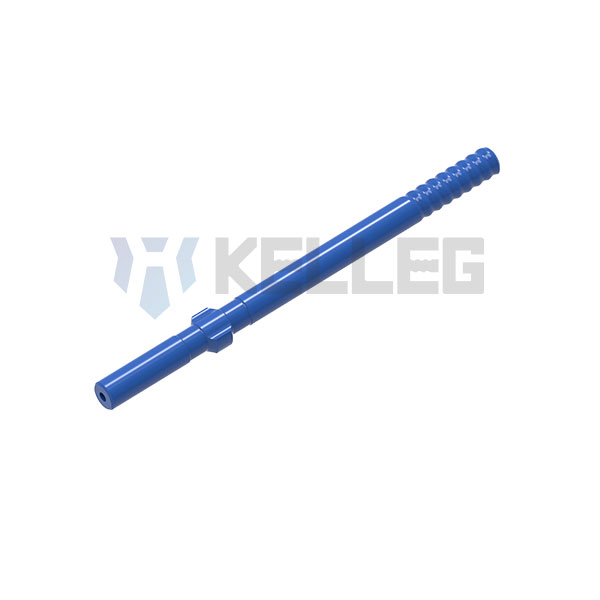2020 官网升级中!现在您访问官网的浏览器设备分辨率宽度低于1280px请使用高分辨率宽度访问。
With the rapid development of high-frequency and high-power hydraulic rock drilling equipment, the technical requirements for the connection and coordination of drill rods and rock drills are becoming more and more strict, and the rock drilling tools market is also changing with people’s needs. With the development of rock drilling technology and rock drilling conditions, the shank adapter has also developed into an indispensable and important accessory in modern rock drilling tools.

The shank adapter is an important part of the threaded connection of the rock drilling tool. It directly bears the high-frequency impact and strong torsion of the rock drill during operation and transfers the impact energy of the rock drill piston movement from the end of the shank adapter to the drill rod and the drill bit for rock drilling. At the same time, under the drive of the rotary sleeve of the drill, the torque is transferred to rotate the whole drilling tool system. The inner hole of the shank adapter is also eroded by fast-flowing water and corroded by mineral water. The tough working environment and the complexity of bearing loads have higher requirements on the performance of the shank adapter. The performance of the shank adapter is closely relative to the different materials and production processes. Today, we mainly use the EN40B material to explain the heat treatment process of the shank adapter.
The heat treatment process of the En40B shank adapter is: carburizing – high-temperature tempering – isothermal quenching – low-temperature tempering.
1. Carburizing
The carburizing process is a kind of chemical heat treatment. Chemical heat treatment is to put the steel workpiece in a chemical medium, through heating and heat preservation, infiltrate some elements of the chemical medium into the surface of the workpiece, thereby changing the chemical composition of the surface layer. The core and surface layers have different tissue and mechanical properties.
2. Isothermal quenching
Isothermal quenching is to put the heated shank adapter into a salt bath with a temperature slightly higher than the Ms point. Generally, the temperature holds for more than half an hour. After the lower bainite transformation occurs, the furnace is air-cooled, and the preheating is adopted in the initial heating to make the shank adapter heated uniform. Isothermal quenching can not only ensure that the shank adapter surface obtains much higher residual compressive stress than direct quenching but also, more importantly, the Ms point of En40B steel is decreased by more than 120 °C because of the carburizing result. The presence of an appropriate amount of retained austenite is very beneficial to improve the multi-impact bending fatigue resistance of the shank adapter. The lower bainite structure of medium carbon has good toughness and high strength, so it has lower crack sensitivity under the action of multiple shock loads, which can improve the service life of the rock drill shank adapter.
3. Low-temperature tempering
Because the performance of En40B is not high, it can meet the requirements through low-temperature tempering at 200°C. The tempering lasts 2 hours, and the tempering needs to be held for some time to make the core and surface temperature uniform, to ensure that the structure is fully transformed and the quenching stress is fully eliminated. If the tempering time is too short, it will lead to insufficient tempering and make the shank adapter crack in grinding. But too long time tempering will increase the production cost and reduce the utilization rate of the equipment.
The above is the heat treatment process of the En40B shank adapter. Although there are many kinds of materials for the shank adapter, we just take EN40B as an example to explain. In fact, in different regions, the production standards referenced by each manufacturer may also be different. For example, the standard adopted by our company is “GB-T 1301-2008”, so the material used for our shank adapter is 23CrNi3Mo, which belongs to the steel for rock drilling tools. The advantages of its constituent elements are as follows:
1. Chromium (Cr): It improves the strength and hardenability of steel, and plays a role in refining grains, improving toughness and wear resistance, but there is a tendency for the second type of temper brittleness. Steel with high chromium content can increase corrosion resistance. The combination of chromium and nickel elements can improve resistance to oxidation and thermal strength, further improving corrosion resistance.
2. Nickel (Ni): The strength of steel is improved, and the plasticity and toughness are not affected. High content nickel and chromium can significantly improve the corrosion resistance and heat resistance of steel.
3. Molybdenum (Mo): Improve the hot hardness and wear resistance of steel, hinder the growth of steel grains and prevent temper brittleness, improve tempering stability, and improve the hardenability of steel.
Of course, with the continuous development of rock drilling conditions and rock drilling techniques, shank adapter manufacturers will continue to explore the heat treatment process of shank adapters. Only with a deeper understanding of the heat treatment process of the shank adapter can we produce more products meeting the requirements and improving the service life.